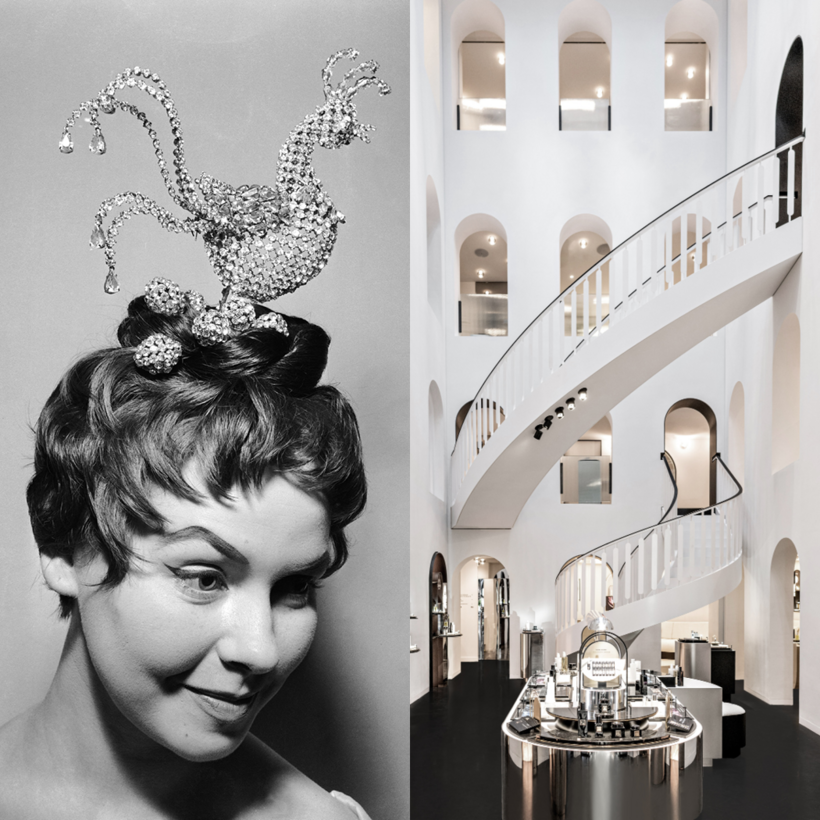On December 15, 1952, a crowd of 3,000 well-heeled socialites and paparazzi gathered in front of 11 Rue du Faubourg Saint-Honoré in Paris to celebrate a momentous occasion for Maria and Rosy Carita—the opening of their multi-level Maison de Beauté.

Over three floors, the Carita sisters had brought together stylists, colorists, hairdressers, makeup artists, manicurist-pedicurists, and masseurs. The Duchess of Windsor, among the sisters’ earliest and most loyal clients, cut the ribbon on their new venture, and assured the house’s reputation as the ne plus ultra in Parisian beauty.
The Spanish-born sisters had opened their first salon in a former butcher’s shop in Toulouse while still in their teens. Encouraged by their clients, they moved to occupied Paris in 1943 and became apprentices to Louis Gervais, a Parisian master and one of the most renowned hairdressers of the age. As the war came to an end he encouraged them to open their own salon, and they soon launched their namesake brand, which featured a holistic approach that was revolutionary for the time. It wasn’t enough to create a singular hairstyle, declared the Caritas; one needed to consider the face it frames, and then extend that care to the rest of the body. “There are no ugly women, just women who look drab,” announced the sisters. “Bringing their beauty to light is our obsession.”

A decades-long stream of movie stars and royalty flocked to the maison for what were considered the industry’s most sophisticated head-to-toe treatments. It was here the duo crafted Catherine Deneuve’s legendary blonde, Françoise Hardy’s oft-copied fringe, and Jean Seberg’s trademark pixie. They re-invigorated the faces of everyone from Grace Kelly to Marlon Brando to Yves Saint Laurent. After the sisters’ deaths, in 1978 and 1982, their nephew Christophe Carita, nicknamed the “Little Prince of Beauty,” ran the business until it was sold to the Japanese cosmetic company Shiseido, in 1986.
“There are no ugly women, just women who look drab.”
Seventy years on from Carita’s grand opening, its legacy lives on. Owned by L’Oréal since 2014, the nearly 20,000-square-foot destination reopened last October after a two-year overhaul. It has a revamped look and feel, upgraded product formulas and treatment protocols, a new distribution strategy with expansion plans for the U.S. and Asia, and a fresh roster of in-the-know clients, most recently Glenn Close and Rami Malek.

The radical redesign, overseen by Cristiano Benzoni and Sophie Thuillier of Rev Studio, begins at the entrance with a striking colonnade made up of overlapping arches that usher visitors into a light-drenched atrium, drawing the eye up six floors to a glass canopy and a floating spiral staircase. The ground floor features a new retail space and curved lounge areas, kitted out with Pierre Paulin pumpkin sofas, meant for one-on-one consultations.

The dramatic proportions lend the house an unmistakable cathedral effect. Cocoon-like treatment rooms are tucked into alcoves off the main atrium, along with star coiffeur, and Carita artistic director, John Nollet’s hair salon. The design treatment extends to Rosy & Maria, the on-site 35-seat restaurant, and up to the top floor in the Look Studio, a space dedicated to makeup and eye enhancements. Adjacent to the studio is the most exclusive space of all: a private, full-size apartment complete with living and dining rooms, hairdressing suite, and treatment room, that is available to rent.
Visually the Carita experience may have changed, but the brand’s positioning at the vanguard of cosmetic philosophy and technology endures. The Carita sisters believed that one might be able to bypass surgical interventions by magnifying a client’s innate aura, a belief that sounds like it could have come straight from our contemporary wellness moment. They saw this aura as being awakened by therapists and facialists using an array of more than 60 unique “choreographed gestures,” high-precision hand movements that boost circulation and the lymphatic system and provide for natural lifting. Similarly, they were keen on incorporating high-tech devices into treatments, such as the Kinesonde and Relaxonde, a philosophy that continues to this day through the use of the Promorphose R.F., an apparatus that employs radio waves to tighten the skin and encourage collagen creation.

It’s this balance of heritage, exclusivity, and house-grown expertise that Charles Finaz de Villaine, Carita’s international brand director, is confident will speak to a new generation of highly discerning beauty-lovers. “These clients don’t buy brands; they buy maisons anchored to an authentic story,” he said. “That’s not something you can invent out of nothing.”
Lindsey Tramuta is a Paris-based culture-and-travel journalist. She is the author of two books, The New Paris: The People, Places & Ideas Fueling a Movement and The New Parisienne: The Women & Ideas Shaping Paris

